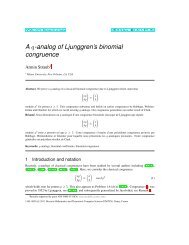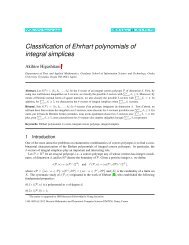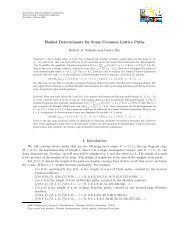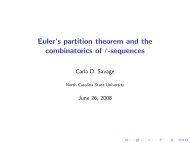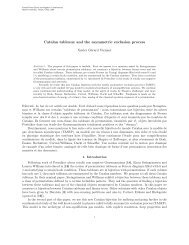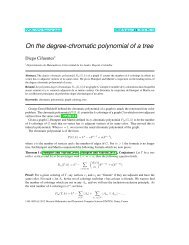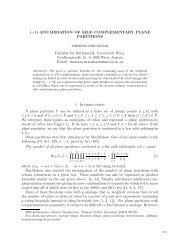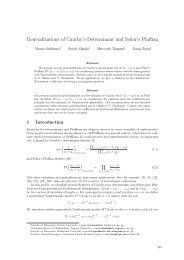Pieri's Formula for Generalized Schur Polynomials - garsia at york
Pieri's Formula for Generalized Schur Polynomials - garsia at york
Pieri's Formula for Generalized Schur Polynomials - garsia at york
Create successful ePaper yourself
Turn your PDF publications into a flip-book with our unique Google optimized e-Paper software.
Formal Power Series and Algebraic Combin<strong>at</strong>orics<br />
Séries Formelles et Combin<strong>at</strong>oire Algébrique<br />
San Diego, Cali<strong>for</strong>nia 2006<br />
Pieri’s <strong>Formula</strong> <strong>for</strong> <strong>Generalized</strong> <strong>Schur</strong> <strong>Polynomials</strong><br />
NUMATA, Yasuhide<br />
Abstract. We define a generaliz<strong>at</strong>ion of <strong>Schur</strong> polynomials as a expansion coefficient of generalized <strong>Schur</strong><br />
oper<strong>at</strong>ors. We generalize the Pieri’s <strong>for</strong>mula to the generalized <strong>Schur</strong> polynomials.<br />
Résumé. Nous définissons une généralis<strong>at</strong>ion de polynômes de <strong>Schur</strong> comme un coefficient de l’expansion<br />
d’opér<strong>at</strong>eurs de <strong>Schur</strong> généralisés. Nous généralisons la <strong>for</strong>mule du Pieri aux polynômes de <strong>Schur</strong> généralisés.<br />
1. Introduction<br />
Young’s l<strong>at</strong>tice is a prototypical example of differential posets defined by Stanley [9]. Young’s l<strong>at</strong>tice<br />
has so called the Robinson correspondence, the correspondence between permut<strong>at</strong>ions and pairs of standard<br />
tableaux whose shapes are the same Young diagram. This correspondence is generalized <strong>for</strong> differential<br />
posets or dual graphs (th<strong>at</strong> is a generaliz<strong>at</strong>ion of differential posets) by Fomin [3].<br />
Young’s l<strong>at</strong>tice also has the Robinson-Schensted-Knuth correspondence, the correspondence between<br />
certain m<strong>at</strong>rices and pairs of semi-standard tableaux. Fomin generalizes the method of the Robinson correspondence<br />
to th<strong>at</strong> of the Robinson-Schensted-Knuth correspondence in his paper [4]. The oper<strong>at</strong>ors in<br />
Fomin [4] are called generalized <strong>Schur</strong> oper<strong>at</strong>ors. We can define a generaliz<strong>at</strong>ion of <strong>Schur</strong> polynomials by<br />
generalized <strong>Schur</strong> oper<strong>at</strong>ors.<br />
A complete symmetric polynomial is a <strong>Schur</strong> polynomial associ<strong>at</strong>ed with a Young diagram consisting of<br />
only one row. <strong>Schur</strong> polynomials s<strong>at</strong>isfy the Pieri’s <strong>for</strong>mula, the <strong>for</strong>mula describing products of a complete<br />
symmetric polynomial and a <strong>Schur</strong> polynomial as sums of <strong>Schur</strong> polynomials like the following;<br />
h i (t 1 , . . . , t n )s λ (t 1 , . . . , t n ) = ∑ µ<br />
s µ (t 1 , . . .,t n ),<br />
where the sum is over all µ’s th<strong>at</strong> are obtained from λ by adding i boxes, with no two in the same column,<br />
h i is the i-th complete symmetric polynomial and s λ is the <strong>Schur</strong> polynomial associ<strong>at</strong>ed with λ.<br />
We generalize the Pieri’s <strong>for</strong>mula to generalized <strong>Schur</strong> polynomials (Theorem 3.2 and Proposition 3.3).<br />
2. Definition<br />
We introduce two types of polynomials in this section. One of them is a generaliz<strong>at</strong>ion of <strong>Schur</strong> polynomials.<br />
The other is a generaliz<strong>at</strong>ion of complete symmetric polynomials. We will show Pieri’s <strong>for</strong>mula <strong>for</strong><br />
these polynomials in Section 3.<br />
2.1. <strong>Schur</strong> Oper<strong>at</strong>ors. First we recall generalized <strong>Schur</strong> oper<strong>at</strong>ors defined by Fomin [4]. We define a<br />
generaliz<strong>at</strong>ion of <strong>Schur</strong> function as expansion coefficients of generalized <strong>Schur</strong> oper<strong>at</strong>ors.<br />
Let K be a field of characteristic zero th<strong>at</strong> contains all <strong>for</strong>mal power series of variables t, t ′ , t 1 , t 2 , . . ..<br />
Let V i be finite dimensional K-vector spaces <strong>for</strong> all i ∈ Z. Fix a basis Y i of each V i so th<strong>at</strong> V i = KY i and<br />
2000 M<strong>at</strong>hem<strong>at</strong>ics Subject Classific<strong>at</strong>ion. Primary 05E10; Secondary 05C78.<br />
Key words and phrases. <strong>Generalized</strong> <strong>Schur</strong> oper<strong>at</strong>ors; Pieri’s <strong>for</strong>mula; Dual graded graph; Differential poset; Symmetric<br />
functions; Binary trees.
NUMATA, Yasuhide<br />
V = KY where Y = ⋃ i Y i. The rank function on V which maps λ ∈ V i to i is denoted by ρ. We say th<strong>at</strong> V<br />
has the minimum ∅ if Y i = ∅ <strong>for</strong> i < 0 and Y 0 = {∅}.<br />
For a sequence {A i } and a <strong>for</strong>mal variable x, we write A(x) <strong>for</strong> the gener<strong>at</strong>ing function ∑ i≥0 A ix i .<br />
Hereafter, <strong>for</strong> i > 0, let D i and U i be linear oper<strong>at</strong>ors on V s<strong>at</strong>isfying ρ(U i λ) = ρ(λ) + i and ρ(D i λ) =<br />
ρ(λ) − i <strong>for</strong> λ ∈ Y . In other words, the images D j (V i ) and U j (V i ) of V i by D j and U j are contained in<br />
V i−j and V i+j <strong>for</strong> i ∈ Z and j ∈ N respectively. We call D i or D(t) and U i or U(t) down oper<strong>at</strong>ors and up<br />
oper<strong>at</strong>ors.<br />
Definition 2.1. Let {a i } be a sequence of elements of K. Down and up oper<strong>at</strong>ors D(t 1 ) · · · D(t n ) and<br />
U(t n ) · · · U(t 1 ) are said to be generalized <strong>Schur</strong> oper<strong>at</strong>ors if the equ<strong>at</strong>ion D(t ′ )U(t) = a(tt ′ )U(t)D(t ′ ) holds.<br />
We write ∗ <strong>for</strong> the conjug<strong>at</strong>ion with respect to the n<strong>at</strong>ural pairing 〈 , 〉 in KY . For all i, U ∗ i and D ∗ i<br />
act as down and up oper<strong>at</strong>ors, respectively. By definition, U ∗ (t ′ )D ∗ (t) = a(tt ′ )D ∗ (t)U ∗ (t ′ ) if D(t ′ )U(t) =<br />
U(t)D(t ′ )a(tt ′ ). Hence down and up oper<strong>at</strong>ors U ∗ (t n ) · · · U ∗ (t 1 ) and D ∗ (t 1 ) · · · D ∗ (t n ) are also generalized<br />
<strong>Schur</strong> oper<strong>at</strong>ors when D(t 1 ) · · · D(t n ) and U(t n ) · · · U(t 1 ) are generalized <strong>Schur</strong> oper<strong>at</strong>ors.<br />
Let down and up oper<strong>at</strong>ors D(t) and U(t) be generalized <strong>Schur</strong> oper<strong>at</strong>ors with {a i } where a 0 ≠ 0. Since<br />
a 0 ≠ 0, there exists {b i } such th<strong>at</strong> a(t)b(t) = 1. Hence the equ<strong>at</strong>ion D(t ′ )U(t) = a(tt ′ )U(t)D(t ′ ) implies<br />
(2.1)<br />
U(t)D(t ′ ) = b(tt ′ )D(t ′ )U(t)<br />
and<br />
(2.2)<br />
D ∗ (t ′ )U ∗ (t) = b(tt ′ )U ∗ (t)D ∗ (t ′ ).<br />
Let ρ ′ be −ρ. We take ρ ′ as rank function <strong>for</strong> the same vertex set V . For this rank function ρ ′ and the vector<br />
space V , D ∗ i and U ∗ i act as down and up oper<strong>at</strong>ors, respectively. Since they s<strong>at</strong>isfy the equ<strong>at</strong>ion (2.2), down<br />
and up oper<strong>at</strong>ors D ∗ (t) and U ∗ (t) are generalized <strong>Schur</strong> oper<strong>at</strong>ors with {b i }. Similarly, it follows from the<br />
equ<strong>at</strong>ion (2.1) th<strong>at</strong> down and up oper<strong>at</strong>ors U(t) and D(t) are also generalized <strong>Schur</strong> oper<strong>at</strong>ors with {b i } <strong>for</strong><br />
ρ ′ and V .<br />
Definition 2.2. Let D(t 1 ) · · · D(t n ) and U(t n ) · · · U(t 1 ) be generalized <strong>Schur</strong> oper<strong>at</strong>ors. For λ ∈ V<br />
and µ ∈ Y , we write s D λ,µ (t 1, . . .,t n ) and s µ,λ<br />
U (t 1, . . .,t n ) <strong>for</strong> the coefficient of µ in D(t 1 ) · · ·D(t n )λ and<br />
U(t n ) · · · U(t 1 )λ, respectively. We call these polynomials s D λ,µ (t 1, . . . , t n ) and s µ,λ<br />
U (t 1, . . .,t n ) generalized<br />
<strong>Schur</strong> polynomials.<br />
<strong>Generalized</strong> <strong>Schur</strong> polynomials s D λ,µ (t 1, . . .,t n ) are symmetric in the case when D(t)D(t ′ ) = D(t ′ )D(t)<br />
but not symmetric in general. It follows by definition th<strong>at</strong><br />
<strong>for</strong> λ, µ ∈ Y .<br />
s D λ,µ(t 1 , . . .,t n ) = 〈D(t 1 ) · · · D(t n )λ, µ〉<br />
= 〈λ, D ∗ (t n ) · · · D ∗ (t 1 )µ〉<br />
= s λ,µ<br />
D ∗ (t 1, . . . , t n )<br />
Example 2.3. Our prototypical example is Young’s l<strong>at</strong>tice Y th<strong>at</strong> consists of all Young diagrams. Let a<br />
basis Y , K-vector space V and rank function ρ be Young l<strong>at</strong>tice Y, the K-vector space KY and the ordinal<br />
rank function ρ which maps Young diagram λ to the number of boxes in λ. Young’s l<strong>at</strong>tice Y has the<br />
minimum ∅ the Young diagram with no boxes. Define U i and D i by U i (µ) = ∑ λ<br />
λ, where the sum is over<br />
all λ’s th<strong>at</strong> are obtained from µ by adding i boxes, with no two in the same column; and by D i (λ) = ∑ µ µ,<br />
where the sum is over all µ’s th<strong>at</strong> are obtained from λ by removing i boxes, with no two in the same column.<br />
Then the oper<strong>at</strong>ors D(t 1 ) · · · D(t n ) and U(t n ) · · · U(t 1 ) are generalized <strong>Schur</strong> oper<strong>at</strong>ors with {a i = 1}. In<br />
this case, both s D λ,µ (t 1, . . .,t n ) and s λ,µ<br />
U (t 1, . . . , t n ) are equal to the skew <strong>Schur</strong> polynomial s λ/µ (t 1 , . . . , t n )<br />
<strong>for</strong> λ and µ ∈ Y.<br />
2.2. Weighted Complete Symmetric <strong>Polynomials</strong>. Next we introduce a generaliz<strong>at</strong>ion of complete<br />
symmetric polynomials. We define weighted symmetric polynomials inductively.
PIERI’S FORMULA<br />
Definition 2.4. Let {a m } be a sequence of elements of K. We define the i-th weighted complete<br />
symmetric polynomial h {am}<br />
i (t 1 , . . .,t n ) by<br />
(2.3)<br />
h {an}<br />
m (t 1 , . . . , t n ) =<br />
{ ∑i<br />
j=0 h{am} j (t 1 , . . . , t n−1 )h {am}<br />
i−j (t n ), (<strong>for</strong> n > 1)<br />
h {am}<br />
i (t 1 ) = a i t i 1 (<strong>for</strong> n = 1).<br />
By definition, the i-th weighted complete symmetric polynomial h {am}<br />
i (t 1 , . . .,t n ) is a homogeneous<br />
symmetric polynomial of degree i.<br />
Example 2.5. When a i equal 1 <strong>for</strong> all i, h {1,1,...}<br />
j (t 1 , . . . , t n ) equals the complete symmetric polynomial<br />
h j (t 1 , . . . , t n ). In this case, the <strong>for</strong>mal power series ∑ i h i(t) equals the gener<strong>at</strong>ing function a(t) = ∑ i ti =<br />
1<br />
1−t . 1<br />
Example 2.6. When a i equal<br />
i!<br />
<strong>for</strong> all i, h { 1 m! }<br />
j (t 1 , . . . , t n ) = 1 i! (t 1 + · · · + t n ) i and ∑ 1 j h{ m! }<br />
j (t) =<br />
exp(t) = a(t).<br />
In general, the <strong>for</strong>mal power series ∑ i h{am} i (t) equals the gener<strong>at</strong>ing function a(t) = ∑ a i t i by the<br />
definition of weighted complete symmetric polynomials. It follows from the equ<strong>at</strong>ion (2.3) th<strong>at</strong> a(t 1 )a(t 2 ) =<br />
∑i h{am} i (t 1 ) ∑ j h{am} j (t 2 ) = ∑ j h{am} j (t 1 , t 2 ). Since the weighted complete symmetric polynomials s<strong>at</strong>isfy<br />
the equ<strong>at</strong>ion (2.3),<br />
a(t 1 ) · · · a(t n−1 )a(t n ) =<br />
∑ i<br />
h {am}<br />
i (t 1 , . . . , t n−1 ) ∑ j<br />
h {am}<br />
j (t n )<br />
= ∑ i<br />
= ∑ i<br />
i∑<br />
k=0<br />
h {am}<br />
i−k (t 1, . . .,t n−1 )h {am}<br />
k<br />
(t n )<br />
h {am}<br />
i (t 1 , . . . , t n )<br />
if a(t 1 ) · · · a(t n−1 ) = ∑ h {am}<br />
i<br />
(t 1 , . . .,t n−1 ). Hence<br />
a(t 1 ) · · · a(t n ) = ∑ i<br />
h {am}<br />
i<br />
(t 1 , . . .,t n )<br />
as in the case when a i = 1 <strong>for</strong> all i. It follows from this rel<strong>at</strong>ion th<strong>at</strong> h {am}<br />
0 (t 1 , . . .,t n ) = a n 0 .<br />
3. Main Theorem<br />
We show some properties of generalized <strong>Schur</strong> polynomials and weighted complete symmetric polynomials<br />
in this section. We show Pieri’s <strong>for</strong>mula (Theorem 3.2 and Proposition 3.3) generalized to our polynomials,<br />
the main results in this paper.<br />
First we describe the commuting rel<strong>at</strong>ion of U i and D(t 1 ) · · · D(t n ). This rel<strong>at</strong>ion implies Pieri’s <strong>for</strong>mula<br />
<strong>for</strong> our polynomials. It also follows from this rel<strong>at</strong>ion th<strong>at</strong> the weighted complete symmetric polynomials<br />
are written as linear combin<strong>at</strong>ions of generalized <strong>Schur</strong> polynomials when V has the minimum.<br />
Proposition 3.1. <strong>Generalized</strong> <strong>Schur</strong> oper<strong>at</strong>ors D(t 1 ) · · · D(t n ) and U(t n ) · · · U(t 1 ) with {a i } s<strong>at</strong>isfy<br />
i∑<br />
D(t 1 ) · · · D(t n )U i = h {am}<br />
i−j (t 1 , . . . , t n )U j D(t 1 ) · · ·D(t n ).<br />
j=0<br />
In the case when the K-vector space V has the minimum ∅, weighted complete symmetric polynomials<br />
are written as linear combin<strong>at</strong>ions of generalized <strong>Schur</strong> polynomials.<br />
Proposition 3.2. For generalized <strong>Schur</strong> oper<strong>at</strong>ors D(t 1 ) · · · D(t n ) and U(t n ) · · ·U(t 1 ) with {a i } on V<br />
with the minimum ∅, the following equ<strong>at</strong>ions hold <strong>for</strong> all i ≥ 0;<br />
s D U i∅,∅ (t 1, . . . , t n ) = h {am}<br />
i (t 1 , . . . , t n )d n 0 u 0,<br />
where u 0 and d 0 ∈ K s<strong>at</strong>isfy D 0 ∅ = d 0 ∅ and U 0 ∅ = u 0 ∅.
NUMATA, Yasuhide<br />
Example 3.1. In the prototypical example Y, Proposition 3.2 means th<strong>at</strong> the <strong>Schur</strong> polynomial s (i)<br />
corresponding to Young diagram with only one row equals the complete symmetric polynomial h i .<br />
Next we consider the case when Y may not have a minimum. It follows from Proposition 3.1 th<strong>at</strong><br />
i∑<br />
〈D(t 1 ) · · · D(t n )U i λ, µ〉 = 〈 h {am}<br />
i−j (t 1 , . . . , t n )U j D(t 1 ) · · · D(t n )λ, µ〉<br />
<strong>for</strong> λ ∈ V and µ ∈ Y . This equ<strong>at</strong>ion implies Theorem 3.2, the main result in this paper.<br />
j=0<br />
Theorem 3.2 (Pieri’s <strong>for</strong>mula). For any µ ∈ Y k and any λ ∈ V , generalized <strong>Schur</strong> oper<strong>at</strong>ors s<strong>at</strong>isfy<br />
s D U iλ,µ (t 1, . . .,t n ) =<br />
i∑<br />
j=0<br />
h {am}<br />
i−j (t 1 , . . .,t n )<br />
∑<br />
ν(∈Y k−j )<br />
If Y has the minimum ∅, this theorem implies the following proposition.<br />
Proposition 3.3. For all λ ∈ V , the following equ<strong>at</strong>ions hold;<br />
where U 0 ∅ = u 0 ∅.<br />
s D U iλ,∅(t 1 , . . .,t n )<br />
〈U j ν, µ〉s D λ,ν (t 1, . . . , t n ).<br />
= h {am}<br />
i (t 1 , . . . , t n )u 0 s D λ,∅(t 1 , . . . , t n )<br />
= s D U i∅,∅(t 1 , . . . , t n )u 0 s D λ,∅(t 1 , . . . , t n ),<br />
Example 3.3. In the prototypical example Y, <strong>for</strong> any λ ∈ Y, U i λ means the sum of all Young diagrams<br />
obtained from λ by adding i boxes, with no two in the same column. Thus Proposition 3.3 is nothing but the<br />
classical Pieri’s <strong>for</strong>mula. Theorem 3.2 means Pieri’s <strong>for</strong>mula <strong>for</strong> skew <strong>Schur</strong> polynomials; <strong>for</strong> a skew Young<br />
diagram λ/µ and i ∈ N,<br />
∑<br />
s κ/µ (t 1 , . . .,t n ) =<br />
κ<br />
i∑ ∑<br />
h i−j (t 1 , . . .,t n )s λ/ν (t 1 , . . .,t n ),<br />
j=0<br />
ν<br />
where the first sum is over all κ’s th<strong>at</strong> are obtained from λ by adding i boxes, with no two in the same<br />
column; the last sum is over all ν’s th<strong>at</strong> are obtained from µ by removing j boxes, with no two in the same<br />
column.<br />
4. More Examples<br />
In this section, we see some examples of generalized <strong>Schur</strong> oper<strong>at</strong>ors.<br />
4.1. Shifted Shapes. This example is the same as Fomin [4, Example 2.1].<br />
Let Y be the set of all shifted shapes. (i.e., Y = {{(i, j)|i ≤ j < λ i + i}|λ = (λ 1 > λ 2 > · · · ), λ i ∈ N}.)<br />
Down oper<strong>at</strong>ors D i are defined <strong>for</strong> λ ∈ Y by<br />
D i λ = ∑ ν<br />
2 cc0(λ\ν) ν,<br />
where cc 0 (λ \ ν) is the number of connected components of λ \ ν which do not intersect the main diagonal;<br />
and the sum is over all ν’s th<strong>at</strong> are s<strong>at</strong>isfying ν ⊂ λ, ρ(ν) = ρ(λ) − i and λ \ ν contains <strong>at</strong> most one box on<br />
each diagonal.<br />
Up oper<strong>at</strong>ors U i are defined <strong>for</strong> λ ∈ Y by<br />
U i λ = ∑ µ<br />
2 cc(µ\λ) µ,<br />
where cc(λ\µ) is the number of connected components of λ\ν; and the sum is over all µ’s th<strong>at</strong> are s<strong>at</strong>isfying<br />
λ ⊂ µ, ρ(µ) = ρ(λ) + i and λ \ µ contains <strong>at</strong> most one box on each diagonal.<br />
In this case, since down and up oper<strong>at</strong>ors D(t) and U(t) s<strong>at</strong>isfy<br />
D(t ′ )U(t) = 1 + tt′<br />
1 − tt ′ U(t)D(t′ ),
PIERI’S FORMULA<br />
down and up oper<strong>at</strong>ors D(t 1 ) · · ·D(t n ) and U(t n ) · · · U(t 1 ) are generalized <strong>Schur</strong> oper<strong>at</strong>ors with a 0 = 1,<br />
a i = 2 <strong>for</strong> i ≥ 1. In this case, <strong>for</strong> λ, µ ∈ Y , generalized <strong>Schur</strong> polynomials s D λ,µ<br />
and sλ,µ<br />
U<br />
are respectively<br />
Q λ/µ (t 1 , . . . , t n ) and P λ/µ (t 1 , . . .,t n ), where P · · · and Q · · · are the shifted skew <strong>Schur</strong> polynomials.<br />
In this case, Proposition 3.2 means<br />
{<br />
h {1,2,2,2,...}<br />
2Q<br />
i<br />
(t 1 , . . .,t n ) = (i) (t 1 , . . . , t n ) i > 0<br />
Q ∅ (t 1 , . . . , t n ) i = 0 .<br />
It also follows th<strong>at</strong><br />
Proposition 3.3 means<br />
h {1,2,2,2,...}<br />
i (t 1 , . . . , t n ) = P (i) (t 1 , . . . , t n ).<br />
h {1,2,2,2,...}<br />
i Q λ (t 1 , . . . , t n ) = ∑ κ<br />
2 cc(λ\µ) Q κ (t 1 , . . .,t n ),<br />
where cc(λ\µ) is the number of connected components of λ\ν; and the sum is over all µ’s th<strong>at</strong> are s<strong>at</strong>isfying<br />
λ ⊂ µ, ρ(µ) = ρ(λ) + i and λ \ µ contains <strong>at</strong> most one box on each diagonal.<br />
4.2. Young’s L<strong>at</strong>tice: Dual Identities. This example is the same as Fomin [4, Example 2.4]. We<br />
take Young’s l<strong>at</strong>tice Y <strong>for</strong> Y. Up oper<strong>at</strong>ors U i are the same as in the prototypical example, (i.e., U i λ = ∑ µ µ,<br />
where the sum is over all µ’s th<strong>at</strong> are obtained from λ by adding i boxes, with no two in the same column.)<br />
Down oper<strong>at</strong>ors D i ′ are defined by D′ i = ∑ µ<br />
µ, where the sum is over all µ’s th<strong>at</strong> are obtained from λ by<br />
adding i boxes, with no two in the same row. (In other words, down oper<strong>at</strong>ors D i ′ remove a vertical strip,<br />
while up oper<strong>at</strong>ors U i add a horizontal strip.)<br />
In this case, since down and up oper<strong>at</strong>ors D ′ (t) and U(t) s<strong>at</strong>isfy<br />
D ′ (t ′ )U(t) = (1 + tt ′ )U(t)D ′ (t ′ ),<br />
down and up oper<strong>at</strong>ors D ′ (t 1 ) · · · D ′ (t n ) and U(t n ) · · · U(t 1 ) are generalized <strong>Schur</strong> oper<strong>at</strong>ors with a 0 = a 1 = 1<br />
a i = 0 <strong>for</strong> i ≥ 2. In this case, <strong>for</strong> λ, µ ∈ Y , generalized <strong>Schur</strong> polynomials s D′<br />
λ,µ equal s λ ′ /µ ′(t 1, . . .,t n ), where<br />
λ ′ and µ ′ are the transposes of λ and µ, s λ ′ /µ ′(t 1, . . .,t n ) are the shifted <strong>Schur</strong> polynomials.<br />
In this case, Proposition 3.2 means<br />
h {1,1,0,0,0,...}<br />
i (t 1 , . . . , t n ) = s (1 i )(t 1 , . . .,t n ) = e i (t 1 , . . . , t n ),<br />
where e i (t 1 , . . .,t n ) stands <strong>for</strong> the i-th elementally symmetric polynomials.<br />
Proposition 3.3 means<br />
e i (t 1 , . . .,t n )s λ (t 1 , . . .,t n ) = ∑ µ<br />
s µ (t 1 , . . . , t n ),<br />
where the sum is over all µ’s th<strong>at</strong> are obtained from λ by adding i boxes, with no two in the same row.<br />
For a skew Young diagram λ/µ and i ∈ N, Theorem 3.2 means<br />
∑<br />
i∑ ∑<br />
s κ/µ (t 1 , . . .,t n ) = h i−j (t 1 , . . .,t n )s λ/ν (t 1 , . . .,t n ),<br />
κ<br />
j=0<br />
ν<br />
where the first sum is over all κ’s th<strong>at</strong> are obtained from λ by adding i boxes, with no two in the same row;<br />
the last sum is over all ν’s th<strong>at</strong> are obtained from µ by removing j boxes, with no two in the same row.<br />
4.3. Planar Binary Trees. Let F be the monoid of words gener<strong>at</strong>ed by the alphabet {1, 2} and 0<br />
denotes the word of length 0. We identify F with a poset by v ≤ vw <strong>for</strong> v, w ∈ F. We call an ideal of poset F<br />
a planar binary tree or shortly a tree. An element of a tree is called a node of the tree. We write T <strong>for</strong> the set<br />
of trees and T i <strong>for</strong> the set of trees of i nodes. For T ∈ T and v ∈ F, we define T v by T v := {w ∈ T |v ≤ w}.<br />
Definition 4.1. Let T be a tree and m a positive integer. We call a map ϕ : T → {1, . . .,m} a<br />
left-strictly-increasing labeling if<br />
• ϕ(w) < ϕ(v) <strong>for</strong> w ∈ T and v ∈ T w1 and<br />
• ϕ(w) ≤ ϕ(v) <strong>for</strong> w ∈ T and v ∈ T w2 .<br />
We call a map ϕ : T → {1, . . ., m} a right-strictly-increasing labeling if
NUMATA, Yasuhide<br />
• ϕ(w) ≤ ϕ(v) <strong>for</strong> w ∈ T and v ∈ T w1 and<br />
• ϕ(w) < ϕ(v) <strong>for</strong> w ∈ T and v ∈ T w2 .<br />
We call a map ϕ : T → {1, . . ., m} a binary-searching labeling if<br />
• ϕ(w) ≥ ϕ(v) <strong>for</strong> w ∈ T and v ∈ T w1 and<br />
• ϕ(w) < ϕ(v) <strong>for</strong> w ∈ T and v ∈ T w2 .<br />
First we consider a present<strong>at</strong>ion of increasing labelings as sequences of trees. For a tree T ∈ T, we<br />
call a node w ∈ T an l-node in T if T w ⊂ {w1 n |n ∈ N}. A node w ∈ T is called an r-node in T if T w ⊂<br />
{w2 n |n ∈ N}. By the definition of increasing labelings ϕ, the inverse image ϕ −1 ({1, . . .,n}) is a tree <strong>for</strong> each<br />
n. For a right-strictly-increasing labeling ϕ, ϕ −1 ({1, . . ., n+1}) \ϕ −1 ({1, . . .,n}) consists of some l-nodes in<br />
ϕ −1 ({1, . . .,n+1}). Conversely, <strong>for</strong> a left-strictly-increasing labeling ϕ, ϕ −1 ({1, . . .,n+1})\ϕ −1 ({1, . . ., n})<br />
consists of some r-nodes in ϕ −1 ({1, . . .,n + 1}). Hence we respectively identify right-strictly-increasing and<br />
left-strictly-increasing labelings ϕ with sequences (∅ = T 0 , T 1 , . . . , T m ) of m + 1 trees such th<strong>at</strong> T i+1 \ T i<br />
consists of some l-nodes and r-nodes in T i+1 <strong>for</strong> all i.<br />
We define linear oper<strong>at</strong>ors D and D ′ on KT by<br />
∑<br />
DT :=<br />
T ′ ,<br />
D ′ T :=<br />
T ′ ⊂ T; T \ T ′ consists of some l-nodes<br />
∑<br />
T ′ ⊂ T; T \ T ′ consists of some r-nodes<br />
Next we consider binary-searching trees. For T ∈ T, let s T be {w ∈ T | If w = v1w ′ then v2 ∉ T.<br />
w2 ∉ T.}. The set s T is a chain. We define S T by the set of ideals of s T . For s ∈ S T , we define T ⊖ s by<br />
{<br />
T (s = ∅)<br />
T ⊖ s :=<br />
(T − max(s)) ⊖ (s \ {max(s)}) (s ≠ ∅),<br />
where<br />
T − w = (T \ T w ) ∪ {wv|w1v ∈ T w }<br />
<strong>for</strong> w ∈ T such th<strong>at</strong> w2 ∉ T. There exists the n<strong>at</strong>ural inclusion ν from T − w to T defined by<br />
{<br />
ν(v ′ w1v v ′ = wv ∈ T w<br />
) =<br />
v ′ v ′ ∉ T w .<br />
This inclusion induces the inclusion ν : T ⊖ s → T. For a binary-searching labeling ϕ from T ∈ T to<br />
{1, . . .,m}, by the definition of binary-searching labeling, the inverse image ϕ −1 ({m}) is in S T . The map<br />
ϕ ◦ ν induced from ϕ by the n<strong>at</strong>ural inclusion ν : T ⊖ ϕ −1 ({m}) → T is a binary-searching labeling<br />
from T ⊖ ϕ −1 ({m}) to {1, . . ., m − 1}. Hence we identify binary-searching labelings ϕ with sequences<br />
(∅ = T 0 , T 1 , . . . , T m ) of m + 1 trees such th<strong>at</strong> there exists s ∈ S T i+1 s<strong>at</strong>isfying T i = T i+1 ⊖ s <strong>for</strong> each i.<br />
We define linear oper<strong>at</strong>ors U on KT by<br />
UT := ∑<br />
s∈S T<br />
T ⊖ s.<br />
These oper<strong>at</strong>ors D(t ′ ), D ′ (t ′ ) and U(t) s<strong>at</strong>isfy the following equ<strong>at</strong>ions;<br />
D(t ′ )U(t) = 1<br />
1 − tt ′ U(t)D(t′ ),<br />
D ′ (t ′ )U(t) = (1 + tt ′ )U(t)D ′ (t ′ ).<br />
Hence the generalized <strong>Schur</strong> polynomials <strong>for</strong> these oper<strong>at</strong>ors s<strong>at</strong>isfy the same Pieri’s <strong>for</strong>mula as in the case<br />
of the classical Young’s l<strong>at</strong>tice and its dual construction.<br />
In this case, generalized <strong>Schur</strong> polynomials are not symmetric in general. For example, since<br />
U ∗ (t 1 )U ∗ (t 2 ){0, 1, 12}<br />
= U ∗ (t 1 )({0, 1, 12} + t 2 {0, 2} + t 2 2{0})<br />
= ({0, 1, 12} + t 1 {0, 2} + t 2 1{0}) + t 2 ({0, 2} + t 1 {0}) + t 2 2({0} + t 1 ∅),<br />
T ′ .
PIERI’S FORMULA<br />
s U ∗<br />
{0,1,12},∅ (t 1, t 2 ) = s {0,1,12},∅<br />
U<br />
(t 1 , t 2 ) = t 1 t 2 2 is not symmetric.<br />
For a labeling ϕ from T to {1, . . .,m}, we define t ϕ = ∏ w∈T t ϕ(w). For a tree T, it follows th<strong>at</strong><br />
s T,∅<br />
U (t ∑<br />
1, . . .,t n ) =<br />
t ϕ ,<br />
s D T,∅ (t 1, . . .,t n ) =<br />
s D′<br />
T,∅ (t 1, . . .,t n ) =<br />
ϕ; a binary-searching labeling<br />
∑<br />
ϕ; a right-strictly-increasing labeling<br />
∑<br />
ϕ; a left-strictly-increasing labeling<br />
These generalized <strong>Schur</strong> polynomials s T,∅<br />
U (t 1, . . .,t n ) in this case are the commut<strong>at</strong>iviz<strong>at</strong>ions of the basis<br />
elements P T of PBT in Hivert-Novelli-Thibon [7].<br />
References<br />
[1] Fomin,S., <strong>Generalized</strong> Robinson-Schensted-Knuth correspondence, Zar. Nauchn. Sem. Leningrad. Otdel. M<strong>at</strong>. Inst. Steklov.<br />
(LOMI) 155(1986), 156–175,195 (Russian); English transl., J.Soviet M<strong>at</strong>h. 41(1988), 979–991.<br />
[2] Fomin,S., Duality of graded graphs, J. Algebra Combin. 3 (1994) 357-404.<br />
[3] Fomin,S., Schensted algorithms <strong>for</strong> dual graded graphs, J. Algebraic Combin. 4(1995),5–45.<br />
[4] Fomin,S., <strong>Schur</strong> Oper<strong>at</strong>ors and Knuth Correspondences, J. of Combin<strong>at</strong>oric theory, Series A. 72(1995),277-292.<br />
[5] Fulton,W., Young Tableaux; with applic<strong>at</strong>ions to represent<strong>at</strong>ion theory and geometry, volume 35 of London M<strong>at</strong>hem<strong>at</strong>ical<br />
Society Student Texts, Cambridge University Press,New York, 1997.<br />
[6] Gessel,Ira M., Counting p<strong>at</strong>hs in Young’s l<strong>at</strong>tice, J. St<strong>at</strong>istical planning and inference. 34(1993),125–134.<br />
[7] Hivert, F., Novelli, J., and Thibon, J. 2005. The algebra of binary search trees. Theor. Comput. Sci. 339, 1 (Jun. 2005),<br />
129-165.<br />
[8] Roby,T., Applic<strong>at</strong>ions and extensions of Fomin’s generaliz<strong>at</strong>ion of the Robinson-Schensted correspondence to differential<br />
posets, Ph.D.thesis, M.I.T., 1991.<br />
[9] Stanley,R., Differential posets, J.American M<strong>at</strong>h. Soc, 1(1988), 919–961.<br />
[10] Stanley,R., Vari<strong>at</strong>ions on differential posets, Invariant theory and tableaux (Stanton,D.,ed.), IMA volumes in m<strong>at</strong>hem<strong>at</strong>ics<br />
and its applic<strong>at</strong>ions, Springer-Verlag, New York, pp.145–165.<br />
Department of M<strong>at</strong>hem<strong>at</strong>ics, Hokkaido University, Japan<br />
E-mail address: nu@m<strong>at</strong>h.sci.hokudai.ac.jp<br />
URL: http://www.m<strong>at</strong>h.sci.hokudai.ac.jp/~nu/<br />
t ϕ ,<br />
t ϕ .



